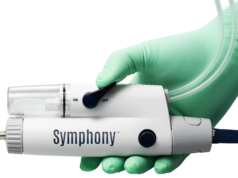
The latest data from the European Vascular and Endovascular Monitor (EVEM) shows that the number of endovascular aneurysm repairs (EVAR) for abdominal aortic aneurysms continues to grow strongly in most European countries. Stephen Greenhalgh, London, UK, presented at the data in November 2006 at the Carpe Diem Vascular meeting in Barcelona, Spain.
In a presentation entitled, “Impact of EVAR and DREAM trials on AAA procedures: Lessons learned from the US and European Vascular and Endovascular Monitors,” he outlined the results from two leading EVAR trials, assessed their impact doctors and examined whether the results has affected the number of AAA procedures undertaken in Europe and the US.
Greenhalgh began by outlining the conclusions of both the EndoVascular Aneurysm Repair (EVAR) and Dutch Randomised Endovascular Aneurysm Management (DREAM) trials. The 30-day mortality results of the UK EVAR 1 trial published online by The Lancet (Wednesday August 25 2004) showed that EVAR reduced death at 30-days by around two-thirds vs. open repair.
Upon disclosing the results, Principal investigator of EVAR Trials Professor Roger Greenhalgh, Imperial College, London, commented, “These early results with EVAR, applied to large aneurysms in suitable patients, provide justification for continued use of this technique in controlled or trial settings; however, the early promise of endovascular repair cannot be guaranteed and might not endure in the long term. These 30-day mortality results are a license to continue scientific evaluation of EVAR, but not to change clinical practice.”
The 30-day mortality results of the DREAM trial, published in New England Journal of Medicine (October 14 2004), also showed a lower operative mortality rate with the endovascular procedure at 30-days. At the time of their publication, Principal investigator of DREAM Trial, Professor Jan Blankensteijn, Nijmegen, the Netherlands, commented, “On the basis of the overall results of this trial [DREAM], endovascular repair is preferable to open repair in patients who have an abdominal aortic aneurysm that is at least 5cm in diameter.”
The publication of the EVAR 1 and 2 Trials and DREAM Trial in June 2005 provoked intense interest from patients, the media and industry alike. The EVAR 1 trial showed that a significant 3% operative mortality benefit of EVAR over open repair is maintained in terms of aneurysm-related mortality, but not significant difference in terms of all-cause mortality in the four-year follow-up. On seeing the results, Professor Greenhalgh commented, “The trial results will affect clinical practice at once. There will be cautious enthusiasm for the use of in low risk patients….”
However, the DREAM results at one- and two-year follow-up showed there was no significant difference in all-cause mortality. The trialists interpreted this result as showing that endovascular repair benefits are lost within a year. However, Dr Frank Lederle, trial coordinator of the US Open Versus Endovascular Repair (OVER) trial questioned these conclusions. “The primary endpoint of the DREAM trial was 30 day outcomes and it was not powered to assess long-term outcomes (with only 38 deaths overall).”
At the 29th Charing Cross International Symposium, almost a year after both results were published, many physicians were still divided on whether EVAR or open repair was the better option for patients suitable for both treatments. When the audience was asked to support or reject the motion: “EVAR trial 1 and DREAM trial results have swung the choice towards endovascular repair and away from open repair in patients anatomically suitable for both” 55% voted against. Presumably this means that the audience thinks that the EVAR 1 and DREAM trials have swung the choice towards open repair.
The EVAR 2 mid-term results showed that in the patients who were unfit for an open repair for whom EVAR was originally developed, there was no demonstrable benefit in terms of either mortality or quality of life, and 7% of patients died in the first 30-days after the elective operation. Professor Janet Powell, member of the Trial Management Committee, said, “If the patient is high risk, the emphasis should be to get the patient fit enough first rather than perform early EVAR.”
Again, at the 29th Charing Cross International Symposium, many physicians were divided when asked to support or reject the motion: “In patients unfit for open repair, the focus should be on improving fitness rather than performing EVAR early.” The motion was supported by 58% and was subsequently described by Drs Rodney White, Ted Diethrich and others as ‘a very confusing finding’.
More recently the publication in Belgium (October 2005) of a health and technological assessment (HTA) of (EVAR) appalled many enthusiasts by concluding that “the introduction of EVAR (and the rest of the world, for that) was a failure.” The report determined that EVAR compared with open surgery “is not cost effective”, and concluded that “we advise against introduction of EVAR in routine healthcare.”
However, a EUROSTAR report concluded that the evidence for “the rejection of EVAR for routine clinical practice cannot be justified” and that “there are currently no reliable data upon which to base calculations of cost-effectiveness.” The latest report entitled, “EUROSTAR Report On Belgian Endovascular Abdominal Aortic Aneurysm Elective Repair Between 2001 And 2005 – EUROSTAR Report On The RIZIV Convention,” showed that outcome of Belgian patients following endovascular repair of AAA compare “very well” with standard for Europe as a whole as determined by the EUROSTAR registry.
EVEM methodology and outcomes
Given the conflicting message of the EVAR and DREAM trials, the apparent confusion among doctors and the damaging report from the Belgian HTA, the latest data from the EVEM provides an insight into what impact, if any, these events had on EVAR procedures in Europe.
In order to collect data, the EVEM sends out annual short registry questionnaires with Vascular News to some 350 registered centres, with quarterly market data from around 250 centres across Europe that form the EVEM panel and 200 centres in USA that form USVEM. This data is then cross checked/validated national and international registries, and industry sources. EVEM concentrates on establishing numbers the of procedures and tracking change over time. Procedure numbers are based on identifying the number of centres on a country-by-country basis performing vascular and endovascular procedures. Hospital size and population statistics do not come into the calculations.
The outcomes from the EVEM analysis reveal that across Europe, EVAR is a small but growing proportion of AAA procedure and numbers have grown year on year (figure 1). This has coincided with a decline in the number of surgical procedures (figure 2). However, in Belgium EVAR procedure numbers are flat and the Netherlands has seen little growth (figure 3).
Conclusions
The EVAR and DREAM trials were interpreted differently: the EVAR trials were seen as positive for EVAR, whereas the DREAM trial was interpreted as a boost for open repair. Despite the conflicting messages of the trials and confusion among physicians EVAR procedure numbers continue to grow strongly in most European countries. Although there is a slower growth rate for EVAR in the Netherlands and no growth in Belgium, for in the latter at least this can be attributed to the damaging HTA report. In the US, where EVAR penetration is far greater than in Europe, the European trials appear to have had little effect on the clinical practice.
AND ENDOVASCULAR MONITOR
PLEASE CONTACT: MARCO PUPESCHI
ON 00442077368788
OR EMAIL: marco@bibamedical.com
Date: Feb/2007












